A text-to-speech facility in a phone or tablet can be very useful, particularly for allowing people with reading difficulties to 'read' and understand text on the screen of their device. Many other people will also use text-to-speech as a proofreading tool, or as an alternative to reading text from a small screen. Android devices have a range of text-to-speech facilities built-in, with the exact configuration depending on the manufacturer and the Operating System. It is not practical to provide information on every option, so we will focus primarily on Android 6 and Android 9.
Getting and Adjusting Voices for your Android Device
Almost every Android device will have the Google Text-to-Speech Engine built in, while some may have an additional speech engine provided by the manufacturer, for example Samsung devices will usually have the Samsung Text-to-Speech Engine. Apps are available to provide other voices, which you may prefer. Cereproc and Acapela both provide a variety of UK voices, including Scottish voices. Cereproc voices can be installed individually, costing £0.59 each, but with Acapela you install the free app and then buy the voice you want separately at a cost of between £3.99 and £11.99. Some speech engine settings can be adjusted to suit the user's preferences.
Android 6 - tap on the icon for the Settings app, then Language and Input, followed by Text-to-speech options. You will then get a list of the available speech engines:
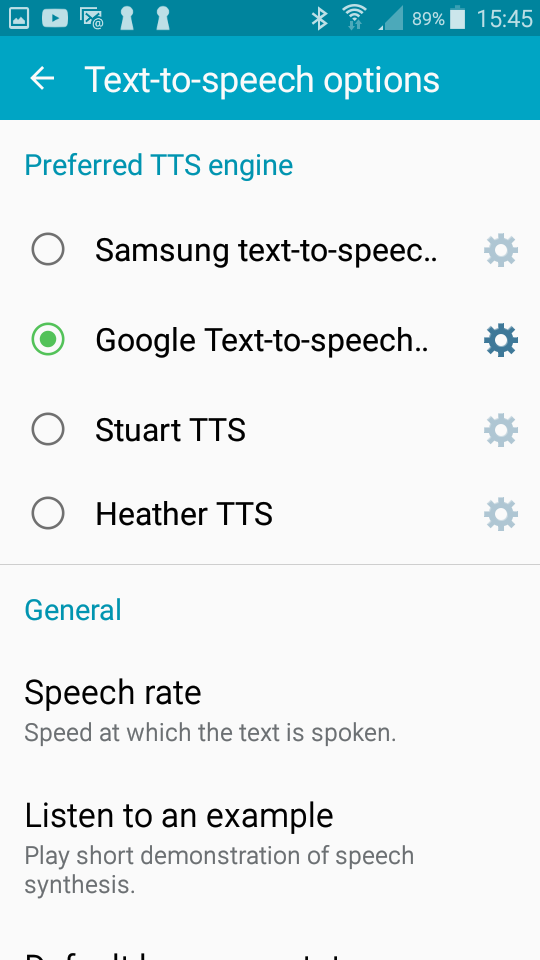
Choose the speech engine you wish to use. You can also use Speech Rate to alter the speed at which text will be read. Tap on the settings cog to the right of the Speech Engine to choose the language you wish to use. If you are using the Google Voice Engine, you might want to make sure that your device has been set up to use UK English by tapping on Language, then English (United Kingdom).
Android 9 - tap on Settings, then General Management, then Language and Input and, finally, Text-to-speech output, under Speech. Now double-tap on Preferred engine to see the voices you have available.
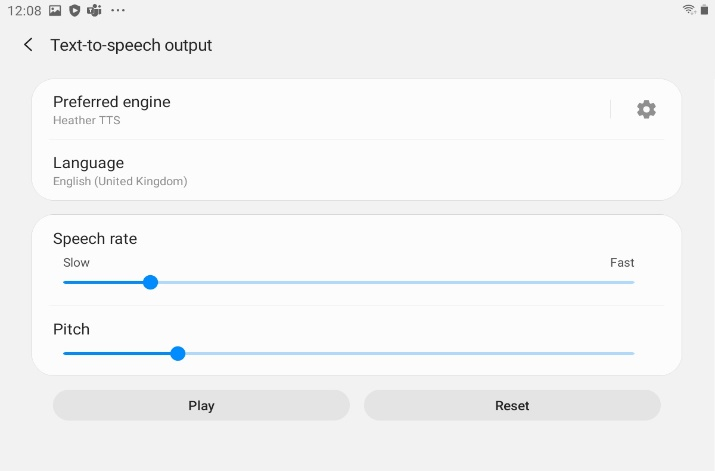
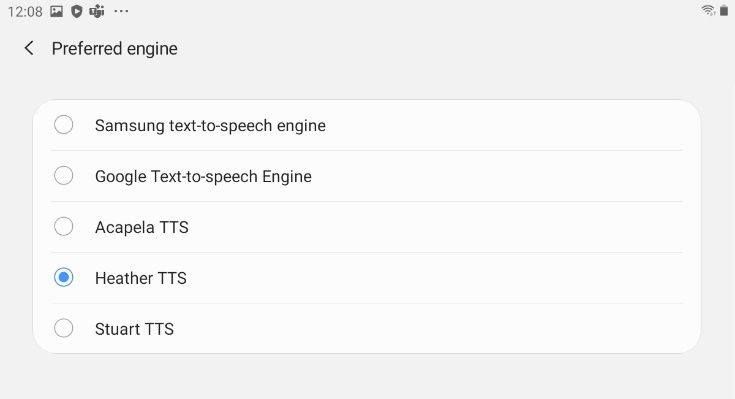
Once you choose a voice, it will become the device's default and will generally be used by almost every text-to-speech app on your device.
Built-in Text-to-Speech
Android devices generally have two built-in speech output systems: a screen reader for people with a visual impairment and Select to Speak, for people who want to listen to text.
Android Screen Readers
Screen readers help people with little or no vision to navigate about the screen and can read content from the screen, but they are complicated to use so we would not recommend them for people with dyslexia or reading difficulties. TalkBack was the original Android screen reader, but it was replaced by Voice Assistant in 2017.
Android 6 - TalkBack can be accessed in Android 6 by tapping on Settings, then Accessibility, then Vision, and finally TalkBack. Lots of settings can be adjusted to control how text is read, navigation, etc. A manual is provided on your device, but TalkBack must be turned on to use the manual.
Android 9 - Voice Assistant is found in Android 9 by tapping on Settings, then Accessibility, then Screen reader and Voice Assistant. As with TalksBack, there is a comprehensive manual, with information on adjusting various settings to meet the needs of the user. Talkback is still available as an Installed Service in the Accessibility Suite.
Android Select to Speak
People with dyslexia and other reading difficulties can benefit greatly by selecting text on the screen and hearing it read out. Select to Speak can be used to read either a piece of text that you have selected on screen, or the entire contents of the screen. Unfortunately, although it works well for reading text in many situations, e.g. emails, most web pages, social media, etc., there are many apps in which it does not work and you just get a message saying "No text found at the location". Sadly, Select to Speak does not work with PDF files (viewed with Acrobat Reader or ezPDFReader); Word Files read in the Word App; or even Google Docs!
Android 6 - Select to Speak can be accessed in Android 6 by tapping on Settings, then Accessibility, then Vision. Tap on Select to Speak and turn it on.
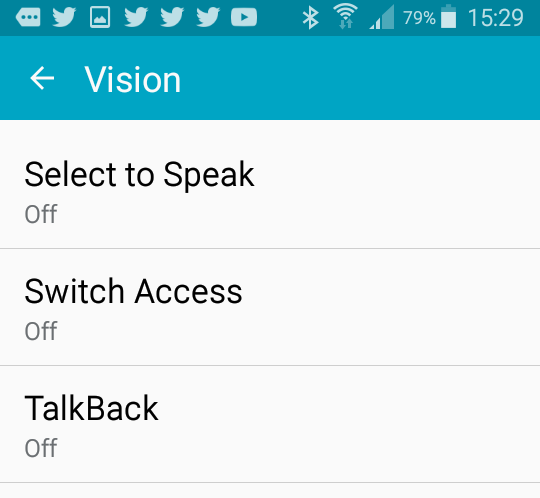
When Select to Speak is turned on, you will see a round icon with a grey speech bubble, which you can move around the screen. Tap on this to activate Select to Speak.

In Android 9, tap on Settings, then Accessibility. If you see an option to choose Select to Speak, tap on it, but you may have to install it as an additional service through the Android Accessibility Suite via Google Play. Once you have installed Select to Speak,you will be able to turn it on by clicking on the Accessibility icon (a small human silhouette) in the bottom, right corner of most screens.
When you activate Select to Speak, a red icon with a mini-toolbar will appear on the screen. You will be able to move this around the screen to suit your preferences.
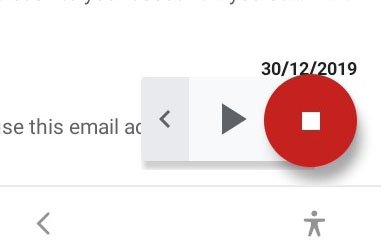
Tap on the Right Arrow to listen to all readable text on the screen. Note that this may include things like tab headings in a web browser, which can be confusing. Tap on the small Left arrow to maximise the mini-toolbar. You will then be able to select some text to be read by tapping on the screen and drawing a 'box' around the text that you want to listen to.

Apps That Can Read Text Out Loud
Select to Speak has shortcomings as a reliable, 'general purpose' text-to-speech app, in the way that 'Speak Selection' can read any text that can be selected on an iPad and Ivona MiniReader, NaturalReader and various other programs can do on a Windows PC.
The ideal 'general purpose' text-to-speech app should:
- speak any text that can be selected on the screen;
- allow text to be read with a variety of voices;
- read the text in its current location so it can be seen in context;
- highlight each word, or sentence, as it is being read to make it easier to follow the text;
- allow a choice of background and text colours when highlighting;
- be easy to use.
There are dozens of free, or low cost, text-to-speech apps for Android - search for Text-to-Speech apps in the Google Play store to get a list with many, but not necessarily, all of the options. The app that comes closest to the ideal is T2S: Text to Voice, the only one we have found to read text directly from its location, without transferring to an editing window in the text-to-speech app. We have successfully tested T2S with text in:
- Google Docs
- Microsoft Word documents
- PDF documents opened in Adobe Acrobat
- Websites viewed with the Google Chrome browser (T2S also has a built-in browser, which works very well for text-to-speech' see below)
- Digital books viewed in Kindle and Play Books
- Social Media - Facebook and Twitter.
We have detailed information about using the T2S: Text to Voice app in a recent blog.
Text-to-Speech Support in Apps
Text to Speech for PDF documents, e.g. some digital books, digital exams, documents
- ezPDF Reader - Comprehensive, but complicated PDF viewer and editor. Includes text-to-speech facilities via button on toolbar, and by selecting text.
- ClaroPDF - Basic, easy to use document reader, with text-to-speech, though currently only seems to work with built-in Google voice.
- Voice Dream Reader - Very flexible PDF and eBook reader, with wide range of accessibility options, including text-to-speech, text size, font and colour adjustments to meet the needs of individual pupils. Includes a facility to switch between the original document and the 'accessible' version. Can be complicated to use.
Text to Speech for Digital Books
- Play Books - Provides access to eBooks and audiobooks downloaded from the Play Store. Tap the three vertical dots (top right) and select Read Aloud to start reading, using the current default voice on the Android. Individual sentences will be highlighted as they are read. There is no facility to link eBooks with audiobooks to provide narration by a human voice.
- Kindle - The Kindle app for Android doesm't have built-in text-to-speech, but text can be copied and read by the T2S app. However, if you have the Kindle and Audible versions of a book it is possible to link them, with the text in the Kindle app highlighted as it is read by a human voice.
- Moon+ Reader Pro - This is a pretty decent reading app for eBooks and PDFs, providing text-to-speech and a range of other accessibility features.
Web Browsers
Most web browsers for Windows, Macs and iOS now provide built-in tools to make web pages easier to read, by removing adverts and other clutter, making text more readable and providing text-to-speech. Some of these facilities are available in Android browsers, but features are more limited. An icon like a 'page' will appear beside the web address if accessibility features (usually referred to as Reader View or Reading View) are available for that page. If good text-to-speech support is very important for you, consider T2S - see above.
- Chrome - Has an option to Show simplified view, which removes adverts and pictures, allows limited changes to text and background colour, but does not have text-to-speech.
- Edge - Reading View in the Android app is very limited compared with Windows, just removing pictures and clutter and providing text-to-speech, using a Microsoft voice.
- Firefox - Reader View keeps pictures embedded in the original article, but removes clutter and allows limited choices for text appearance and colour scheme. There is no text-to-speech facility.









Our social media sites - YouTube, Twitter and Facebook